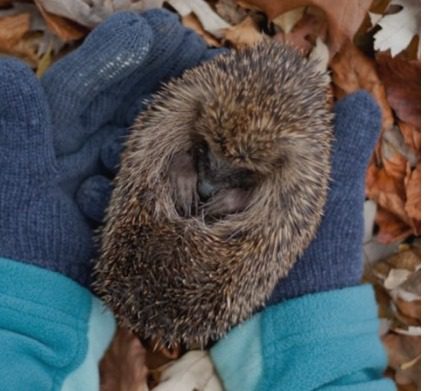Guide To Helping Hedgehogs
Having experienced a hedgehog nesting in my garden at first hand recently, I was painfully aware that I didn’t have a clue about how to treat these intriguing little visitors. Here is our guide to helping hedgehogs.
A Harsh Lesson
It was a bittersweet experience. I’d seen the hedgehog in the garden on one occasion early one morning and had also noticed some peculiar black droppings that definitely weren’t from my cat.
It was only when I took the lawnmower out from its resting place in the corner of the garden that I saw the creature had started building a nest behind it. The mother had piled leaves, grass and twigs on top of a hole she had dug out of the gravel next to the fence. She had also cleared a small depression under the fence next to the nest to get underneath it and access the garden next door.
I say bittersweet because I’d obviously disturbed her, and although I put the mower back, I never saw the mother again. I revisited the nest a week or so later to investigate. It was abandoned and, on closer inspection, I found three dead babies in the hole. It was a horrible experience. I later read that once a nest is disturbed, the mother will abandon it and sometimes kill any offspring.
All this, and the fact I started seeing so many online posts from local people who had had similar experiences to me, made me decide to write a story that would help people cope better than I did when hedgehogs appear in their garden.
Cat-Proof Boxes

In the 1950s, there were an estimated 36.5 million hedgehogs in Britain, but this was based on limited data and was probably an overestimate. Only two reliable estimates of the population size exist, and both acknowledge a lot of uncertainty in the figures. In 1995, and more recently in 2017, researchers have suggested a figure of about 1.5 million hedgehogs across England, Scotland and Wales collectively.
There is now evidence that these numbers have been declining since then, but is it just me or are people suddenly seeing more of them? I read this on my local Nextdoor feed the other day: “I am surprised at the number of people feeding hedgehogs. A few years ago we didn’t have any in our garden. This year, I’ve had at least four this summer. You do need a cat-proof box as cats go crazy for hedgehog pellets – my hogs prefer Mr Johnsons to Brambles.”
Annie Maluver from Brymbo is a good contact if you want information on rehoming or looking after a hedgehog. You call her on 07746 904 471 or email her at ljkenton@btinternet.com.
A Square Mile A Night

You can find hedgehogs throughout most of the UK. Gardens, hedgerows, woodland, grassland, parks and cemeteries are all important hedgehog habitats. Adults can travel up to a square mile per night searching for food and mates – that’s entire housing estates and neighbourhoods!
With dwindling daylight and food sources becoming more limited, hedgehogs are at a crucial stage of the year. They need to build up their weight to around 600g to stand any chance of living through winter hibernation. Hoglets born late in the year probably won’t survive now unless they are lucky enough for somebody to rescue them and take them to a hedgehog sanctuary.
Wrexham’s hedgehog centre is at Horsley Cottage, Pistyll Hill, Marford LL12 8LE (tel: 01978 856 237).
You Can Give A Helping Hand
Changes in house-owner’s gardening habits, such as replacing lawns with gravel or astroturf and more solid concrete fencing, have made it more difficult for hedgehogs to move around or forage for food.
You can take elementary steps to improve their chances of survival by increasing access to and from your garden. Making a hole in or removing earth from underneath fences and removing single bricks from the bottoms of walls allow free movement. You can use the spare bricks to create a little tunnel to keep cats out!
Finally, don’t be too tidy! Try to leave some form of dry and safe shelter so they can rest or take cover and be very careful when making bonfires.
Handling and Care
Hedgehogs usually hibernate between November and mid-March, but you can sometimes see them out and about during this period changing nesting sites. It is unusual to see a hedgehog during winter or in daylight, so if you do spot one, it may be unwell and need a helping hand if you do see one.

Hedgehogs are wild animals, so avoid handling them as this will only stress them. Some less-invasive and straightforward steps are to put down some fresh water and food (don’t try to feed the hedgehog directly) at dusk. Milk is a definite no-no as hedgehogs are lactose intolerant, and drinking milk will lead to severe dehydration.
Cat food, either wet or dry, is ideal. This kind of food is better than so-called hedgehog food as it is more nutritious. Mealworms are not a good choice as these cause calcium deficiency. Avoid giving them bread as well.
If the hogs haven’t eaten the food, remove anything that will go off and replace it with fresh offerings the following evening. Research suggests that unpredictable supplementary feeding is beneficial, eg moving the feeding spots around and scattering food more naturally.
Avoid any interaction with dogs. Sadly, dog bites frequently cause injury or death to hedgehogs. If your pets insist on gobbling down the food for themselves, make a protected feeder out of an inverted cardboard or plastic box with a hedgehog-sized hole in it and put the food inside that.
Learn how to build a hedgehog-friendly shelter by going to wildaboutgardens.org.uk. Click on “Hedgehogs” at the very bottom of the page.
We hope you enjoyed our article about helping hedgehogs. Click here for more home and garden-related articles.
Guide To Helping Hedgehogs

